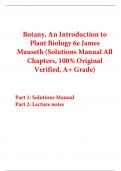Botany, An Introduction to
Plant Biology 6e James
Mauseth (Solutions Manual All
Chapters, 100% Original
Verified, A+ Grade)
Part 1: Solutions Manual
Part 2: Lecture notes
,Solutions to Review Questions in Chapters 1, Botany: An Introduction to Plant Biology, Sixth
Edition
Notes to Instructor: All questions are in regular font, all answers are in bold. Some
questions ask for answers about two or more things within a single sentence of the question, and
for those, the answer is inserted into the sentence in square brackets [ ]. If a sentence needs only
one answer, then it is given in bold, after the sentence. If the question is a fill-in-the-blank
question, then some of the leading and following underscore marks are left around the bolded
answer. In questions that ask the student to circle one answer in a series of words, the correct
answer is indicated by use of bold within the series.
Notes to the instructor are in bold and are preceded with “Note.”
Chapter 1. Introduction to Plants and Botany.
1. Your present concept of plants is probably quite accurate. Most have roots, stems,
leaves, and flowers. Can you name two plants that have cones rather than flowers? Note: The
examples mentioned in text: pine, spruce, fir. Can you name a plant that appears to not have
leaves? Many cacti and succulents.
2. Name two types of fungi. Mushrooms and puffballs. Why were fungi originally
included in the plant kingdom? Because they are immobile and produce spores. Biologists no
longer consider fungi to be plants because they differ in many basic _biochemical_ and
_genetic_ aspects.
3. How would you distinguish between plants and animals? What characters are
important? Be careful to consider unusual plants and animals. Can all animals move? Do they all
1
© 2017 Jones & Bartlett Learning, LLC
,eat? Note: The answer to this is not in the text; it is intended to stimulate the students to
think about the plants and animals they already know.
4. What are four methods for analyzing nature? Name some advantages and
disadvantages of each. 1. The religious method (advantage: it can deal with things that are
intangible, things that cannot be analyzed physically or chemically, such as morality;
disadvantage: it is not very useful for analyzing things that are tangible such as minerals,
atoms, animals, and plants), 2. metaphysical system (advantage: there are no obvious uses
for this; disadvantage: it cannot be used to analyze any part of the nature), 3. speculative
philosophy (advantage: this allows us to think about and analyze things even though it is
not yet possible to test them (for example, many aspects of mathematics, physics,
astronomy, the possibility of life on other planets; disadvantage: there is no obvious
disadvantage – but speculation is used only when the scientific method cannot be used), 4.
the scientific method (advantage: it has been the most successful method of analyzing
tangible aspects of nature; disadvantage: nature has (may have?) some aspects that are not
tangible, such as right and wrong, morality; these cannot be analyzed with the scientific
method).
5. Is it always easy to recognize that something is a living being rather than an inanimate
object? Europa is a moon of Jupiter (Box 1.2), and it is so far from the sun that there is not
enough light for photosynthesis. The bottom of its ocean must be completely dark and icy cold.
Are there locations like this on Earth that support life and which therefore let us hypothesize that
life might also exist on Europa? Yes, on the ocean floor, obtaining energy from volcanic
gases.
6. In the scientific method, all accepted information can be derived only from
2
© 2017 Jones & Bartlett Learning, LLC
, documented and controlled _observations_ or _experiments_. If someone claimed to have a
new treatment of a disease or a new type of eye surgery, would you want some sort of
documentation and proof before you let them give you drugs or operate on you? Yes.
7. The scientific method deals only with _tangible_ phenomena and objects.
8. Physical forces that control the world are _constant_ through time and are the _same_
everywhere.
9. The fundamental basis of the scientific method is _skepticism_. Describe this concept.
10. What is a hypothesis? A model constructed to account for observations. A theory?
A theory is a hypothesis that continues to match new observations such that we have
greater confidence that it is correct. Why is it important that each be able to predict the
outcome of a future experiment? Hypotheses and theories must predict the outcome of future
experiments or studies; if the predictions are not accurate, then the hypotheses and theories
must not be correct. If the predictions are accurate, they support our confidence in the
hypotheses and theories (but they do not prove that they are correct). How do these differ
from a speculation? Speculation involves thinking logically about a question and developing
a logical answer for a simple observation and taking the logic as far as it would go.
Hypotheses and theories are either supported or rejected by concrete evidence, not just
logic. In speculation, several alternative conclusions may be reached that are equally
plausible; only experimentation reveals which is actually true.
11. If a hypothesis makes predictions that are not accurate and do not help explain future
observations, do those inaccurate predictions prove or disprove that the hypothesis is not a good
model of reality? Inaccurate predictions indicate that the hypothesis is not a good model of
reality. On the other hand, if the hypothesis does make accurate predictions, does that accuracy
3
© 2017 Jones & Bartlett Learning, LLC




